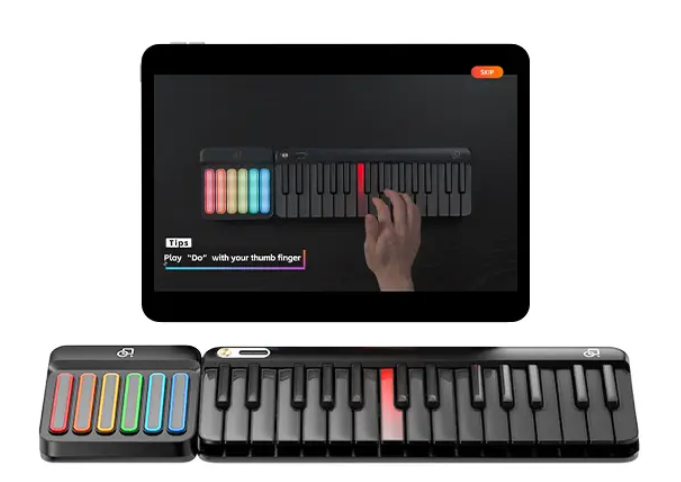
Light‑guided keyboards look like regular digital pianos—until the keys start glowing and practically beg you to press them. The concept feels almost magical, yet the tech behind those dancing LEDs is fairly down‑to‑earth. Let’s unpack the hardware, the software, and the learning science so you can decide whether a luminous set of keys—such as the Smart Keyboard—belongs on your desk.
An acoustic piano is a marvel of levers, felt hammers, and taut steel strings. Press a key, a hammer strikes one to three strings, the strings vibrate, and the wooden soundboard amplifies the result.
That’s the mechanical answer to “how does a piano work,” and it hasn’t changed much since the 1700s. Digital pianos mimic those vibrations with sampled audio and weighted keys, but the core idea—press, sound, sustain—remains the same.
A light‑guided keyboard adds a thin LED strip or individual diodes beneath each key. When the learning software decides it’s time for you to play middle C, that key glows—often in neon blue or rainbow gradients.
Unlike the white backlight you’ll find on a gaming laptop, these LEDs are musical markers that update in real time.
Early adopters include Yamaha’s EZ‑220, whose 61 lighted keys wait for you to hit the right note before the song continues , Yamaha USA. More recently, Roli’s LUMI uses multicolored LEDs so each note of a scale can claim its own hue, turning music theory into something you can literally see.
Miss the note? The LED often stays lit until you correct it, which makes errors impossible to ignore—but also painless to fix.
PopuPiano crams 29 illuminated keys into a 13‑inch chassis and can snap magnetically to an extra 24‑key extension or a wireless chord pad. That modular design keeps the board backpack‑friendly while still offering Self‑PlayAlong keys, 256 built‑in tones, and full MIDI‑controller mode.
Popu’s app turns practice into something closer to a rhythm game. The key you need next flashes, you press it, and the track proceeds. Because the LEDs are bidirectional—you see the notes, and the sensors record your response—the software can score timing, velocity, and accuracy for a mini “report card” at the end of each lesson.
And yes, you can shut the lights off once you’ve memorized a piece. The goal is to wean you off the glow, not keep you dependent forever.
Short answer: no. Long answer: it can jump‑start motivation and pattern recognition but won’t correct wrist posture or phrasing. That’s the same critique reviewers aim at app‑only systems like Simply Piano. In fact, a 2025 review praises Simply Piano’s gamified lessons yet notes its “limited guidance on technique”.
So, does Simply Piano work? Sort of—if you pair it with physical feedback, whether lights, a teacher, or both. A light‑guided keyboard adds the missing tactile‑visual layer the app alone can’t give.
|
Feature |
Backlit Typing Keyboard |
Light‑Guided Music Keyboard |
|
Purpose of LEDs |
Aesthetic & visibility |
Real‑time note guidance |
|
Data Source |
Static on/off |
Dynamic MIDI stream |
|
Interactivity |
None |
Tracks your playing |
|
Skill Transfer |
None |
Builds muscle memory |
PopuPiano’s light system earns extra points because it doubles as stage flair—rainbow waves for performance mode, subtle white for practice. Win‑win.
|
Model |
LED Colors |
Keys |
App Required? |
Notable Perk |
|
Yamaha EZ‑220 |
Red |
61 |
Optional |
Waits until you hit correct note |
|
Roli LUMI |
Full RGB |
24 (expandable) |
Yes |
Color‑theory mode links hues to scales |
|
PopuPiano |
RGB |
29 (53 w/ expansion) |
Yes |
Modular chord pad + 256 sounds |
Why didn’t the piano work? (Answer key)
Nine times out of ten, the culprit is power: dead batteries, an unplugged adapter, or Bluetooth not connected. Check those first before blaming the instrument.
How does a piano work when it’s digital?
A digital piano triggers high‑resolution audio samples through built‑in speakers. No strings, just chips and amplifiers.
Does Simply Piano work on a light‑guided keyboard?
Yes. You can mute PopuPiano’s app and fire up Simply Piano instead; the keys will still light based on incoming MIDI, giving you double feedback.
Light‑guided keyboards take the steepest hill in early piano study—finding the right notes—and flatten it into a gentle ramp. They won’t turn you into Chopin overnight, but they will slash the frustration curve and make practice feel like play. If that sounds like your jam, PopuPiano is an inviting place to start.
Leer más

What Is a Smart Piano Keyboard? The Beginner’s Guide to Digital Learning
Ever wished the piano could lean over your shoulder and whisper, “Ps st… hit the next G‑sharp here”? That’s the basic idea behind a smart piano keyboard—an instrument that blends traditional keys w...

How to Practice Piano While Traveling: Smart Tips for Pianists on the Go
You nailed that left-hand arpeggio—and then a five-day trip pops up. Momentum doesn’t have to disappear. With the right portable piano setup and short, focused routines, you can keep progressing an...